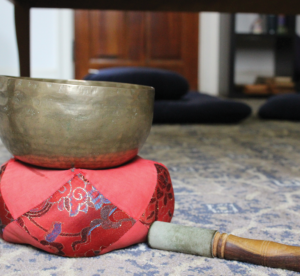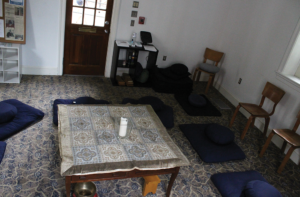
The room is small, bright and quiet, with a small table at the center surrounded by floor cushions and chairs. A meditation leader begins to recite the words of John Main, a British Benedictine monk famed for his meditation techniques, followed by the boom of a gong. Then, silence.
Thus begins a group meditation at the John Main Center for Meditation and Interreligious Dialogue, held twice daily.
Housed inside the small brick Anne Marie Becraft Hall, which is located at the corner of Old North Way and Library Walk in the center of Georgetown University’s campus, the JMC provides a welcoming, inclusive environment for students of all religious backgrounds. Fr. Laurence Freeman, a former meditation student of John Main, established the JMC in 2005 when working as a visiting professor in the Catholic studies department.
A team of nine meditation leaders, who are a mixture of faculty members, recent graduates and students of all levels, lead the ritual. Meditation in the JMC follows Main’s model, in which participants silently repeat a word or phrase, called a mantra. During the twice-daily silent group meditations, students enter the space and take off their shoes before sitting down on cushions.
The meditation leader begins by reading an excerpt from Main and then strikes a gong to signal the start of the 20-minute meditation. The gong is rung again to signal the end of the meditation, after which an excerpt from a work of a different faith from John Main is read.
Meditation’s Religious Roots
The practice of meditation has roots in Catholic tradition even as it holds a universal connection, said Nick Scrimenti (COL ’18), program coordinator for the JMC.
“The idea of meditating and praying with people from other religious traditions or no tradition at all is an important, indeed necessary, dimension of the center,” Scrimenti wrote in an email to The Hoya.
Scrimenti said meditation connects to three elements of Georgetown’s Jesuit identity: contemplation in action, interreligious dialogue and cura personalis.
“We are a diverse community of contemplatives in action who promote inter-religious understanding as well as cura personalis. We have also had fruitful comparisons and fusions of meditation and Ignatian spirituality,” Scrimenti wrote.
Tony Mazurkiewicz, director of the JMC, said one of the best parts of the JMC is that its roots in Catholicism are married with its inclusiveness of students of all religious backgrounds — even those who are unsure of their spiritual footing.
“There are a lot of folks who come through the center who might not be fully connecting with the institutional tradition that they’re involved in, so in many ways we try to meet them where they’re at,” Mazurkiewicz said in an interview with The Hoya.
“At Georgetown we’re Christian, Catholic, Jesuit, so we present meditation from the Christian tradition, but at the same time, Georgetown’s founded on religious pluralism, and so we invite people, particularly who come from different traditions, to enter into the silence together,” Mazurkiewicz said.
Mazurkiewicz also believes that meditation supports the education of the whole person in mind, body and spirit, and embodies contemplation in action.
“Meditation is that deeper reality that folks want to be in touch with: Not only who we are, but whose we are — that relationship with the divine,” Mazurkiewicz said.

Beyond John Main
Besides JMC group meditation sessions, students have also developed other ways to find peaceful moments on campus. Although yoga is a distinct practice from meditation, the two are similar in their emphasis on tranquility and reflection, and meditation is often incorporated into yoga.
Hoyasana, Georgetown’s student yoga club, hosts four free yoga classes per week in the Healey Family Student Center dance studio. Each lasts an hour and is taught by a different teacher.
Dina El-Saharty (GRD ’19), who teaches one of Hoyasana’s classes, finds yoga to be a soothing, meditative practice and concludes each of her classes with a five-minute silent meditation.
Inspired by the benefits of meditation in yoga, El-Saharty has made meditation a common practice in her daily life.
“Over the years, I’ve learned to meditate in between everything that I do,” El-Saharty said. “Often, when I’m walking somewhere, I engage in walking meditation. Walking meditation is great way to remind yourself to slow down in the fast-paced world we live in, to be present and to become aware of your body in full motion.”
Rachael Borrows (COL ’20) has not attended a Hoyasana class, but during her first year at Georgetown she frequently attended student-led Buddhist meditations, which take place at the JMC but are distinct from the silent group meditations. Borrows said the Buddhist meditations opened her eyes to the benefits of meditative practice.
“Participating in meditation at the John Main Center was a formative experience during my freshman year at Georgetown,” she wrote in an email to The Hoya
“During high-stress periods throughout the year, I found great comfort in the practices taught and conducted at the nighttime Buddhist meditation sessions.”
Borrows first attended meditation as part of an assignment for her “The Problem of God” freshman theology class but found it so beneficial that she continued to attend.
“The fact that the sessions I attended at the John Main Center were student-led made them feel comfortable and familiar, and the intimate space was perfect to set the scene for mental relaxation,” Borrows wrote.
Meditative Benefits

For those who actively engage in meditation, the practice seems to reap many rewards.
“Hopefully meditation leads us to a deeper sense of self-acceptance, of self-awareness, of love and kindness and of being comfortable in our own skin,” said Mazurkiewicz, who typically meditates twice per day.
Of the many benefits of meditation, he noted that stress relief, in particular, might resonate with Georgetown students.
“Your heart rate decreases when you begin taking deep breaths,” Mazurkiewicz said. “The practice also helps you become more aware and in some ways peels some of the layers back. When there is a lot of pressure, it’s a way to let go.”
El-Saharty agreed, saying meditation provides innumerable benefits.
“Meditation is truly an amazing practice — so simple, yet so powerful,” El-Saharty said. “It’s an all-encompassing practice and a great and simple way to reboot your entire body and mind, and improve your overall physical, mental, emotional, spiritual and intellectual well-being.”
After years of practice, Scrimenti now meditates each day, sometimes more than once, and cites the myriad benefits.
“You might feel more aware, you might be a better listener, and you might be happier,” Scrimenti wrote, noting that several studies have indicated the positive effects of meditation.
However, Scrimenti was quick to add that JMC group leaders focus more on the immediate practice of meditation than its effects.
“We tend not to emphasize the physical or psycho-physical benefits of meditation. We try not to promote meditation just as a way to become a more efficient worker or as a way to lower blood pressure,” Scrimenti said. “We take a much more holistic approach, attempting to explain why people have historically and religiously felt compelled to meditate.”
At the same time, meditation cannot cure all problems. Yulia Chentsova-Dutton, an associate professor of cultural psychology, pointed to the toxic environment of over-commitment, business and stress promoted by club culture as an issue to resolve.
“I think we can only achieve good results if we do not only address the individual level — teaching students beneficial emotion regulation techniques — but also pay attention to the cultural level,”
Chentsova-Dutton wrote in an email to The Hoya. “We are increasingly understanding that while meditation is effective, we cannot expect people to mediate cultural effects away.”








